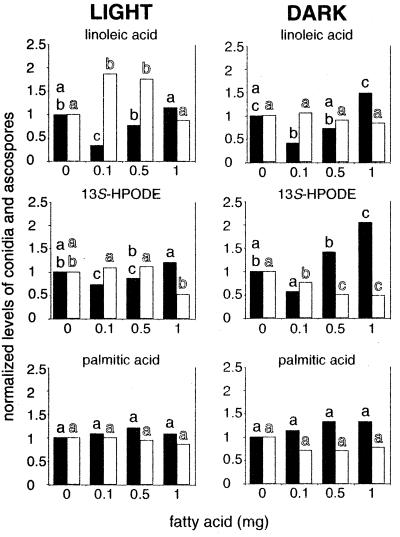FIG. 5.
Effects of different amounts of linoleic acid, 13S-HPODE, and palmitic acid (on discs) on conidial production (solid bars) and ascospore production (open bars) in A. nidulans WIM126, as determined with 5-day cultures grown in continuous light or in complete darkness. Most of the experiments were performed in triplicate; the exception was the 13S-HPODE experiment, in which five replicates were used. 9S-HPODE effects were similar to linoleic acid effects, and oleic acid effects were similar to palmitic acid effects (data not shown). Bars with the same letter are not significantly different (P ≤ 0.05). Data were calculated as explained in the legend to Fig. 4, and in each experiment the data were normalized with respect to the control value, which was 1. The absolute values for the controls were as follows: for the linoleic acid treatment in the light, 2 × 105 conidia and 9 × 104 ascospores; for the linoleic acid treatment in the dark, 6 × 104 conidia and 3 × 105 ascospores; for the 13S-HPODE treatment in the light, 4 × 105 conidia and 2 × 104 ascospores; for the 13S-HPODE treatment in the dark, 1 × 105 conidia and 3 × 105 ascospores; for the palmitic acid treatment in the light, 2 × 105 conidia and 1 × 105 ascospores; and for the palmitic acid treatment in the dark, 5 × 104 conidia and 3 × 105 ascospores.

